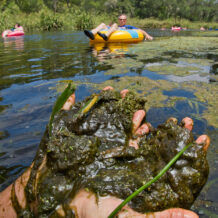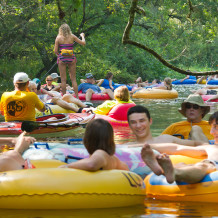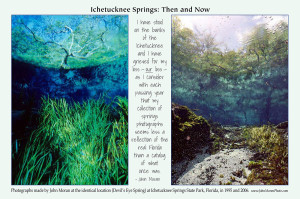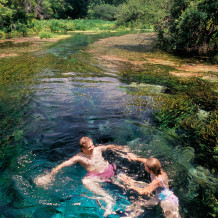caring for your spring
Ichetucknee Springs
The greatest threat to Ichetucknee River is loss of flow. Less water is getting into the aquifer than is being pumped out. While drought has exacerbated this problem in recent years, it accounts for only a fraction of the problem. This has been well-proven by a solid data base of observation stretching back decades, that includes periods of drought as well as wetter periods.
The first measurements of Ichetucknee’s flow were taken in 1946. The record for some other rivers is much longer. Silver River, for instance, has readings dating back to the late 1800’s. All of these data show, without exception, that water levels are steadily declining in all Florida’s springs, regardless of drought cycles. According to the Ichetucknee Restoration Plan produced by the Florida Springs Institute in 2012, the flow of Ichetucknee has declined by 25% since the 1970’s.
The only solution to this problem is to use less water. Of course, one glaring solution would be to reduce the number of Floridians. But, with our policy makers continuing to encourage people to move to Florida, our numbers will likely continue to increase for the foreseeable future. So, the only thing left to do is reduce the amount of water we each use. Floridians use more water, per capita, than any other state besides California. How we choose to conduct our lives will determine the how much water flows from Ichetucknee’s springs. Remember, the water that flows from our faucets and spigots is water that would otherwise have stayed in the aquifer and eventually flowed from a spring. The equation is simple; if we all used less water, more water would flow from the springs.
The biggest user of ground water is agriculture. But we all have a hand in this problem. With a growing population in the Ichetucknee watershed, it is imperative that everyone gets on board to make sweeping changes to our collective mindset. Xeriscaping—using only plants that reduce or eliminate the need to water—needs to be encouraged throughout our community. The easiest and most ecologically beneficial way to do this is to only plant things that would naturally grow here. The Ichetucknee Forest is rich in species that have attractive foliage, beautiful blooms and that can be placed and trimmed in ways that make an attractive landscape. We should work toward a time when timed, automatic irrigation systems are a social taboo. The fact that we still see timed yard sprinklers spraying lawns during rain storms speaks to the overwhelming challenge we face if we are going to be serious about saving the river that brought us all to this place.
Similarly, we need to address the flood of nitrates that are killing the river’s aquatic life. One of the quickest and easiest things we can do to begin healing Ichetucknee River is to completely rethink, and drastically minimize fertilizer applications to our lawns and landscapes. It’s important to note that using small amounts of fertilizer is okay. As long as you apply only the amount the plant will use, then there won’t be excess runoff. This is not only good for the environment and the river; it is good for your wallet. Commercial growers have embraced this notion and are working hard to fine-tune the amount of fertilizer needed to sustain healthy yields with no excess. It’s business, on all levels.
For a scientific perspective on the Ichetucknee that includes information about hydrology and the problems of land use, nitrate nitrogen, algae proliferation and loss of flow, see the Howard T. Odum Florida Springs Institute’s Ichetucknee Springs and River: A Restoration Action Plan. Here you can find suggestions for remediating these springs, which include reducing or eliminating fertilizer, animal and human waste, and implementing water conservation. For a brief outline of specific recommendations for restoration, see this page.
For current information about how you can get involved in protecting and restoring the Ichetucknee, consider joining the Ichetucknee Alliance, which is committed to working with partners in the springshed and throughout Florida to achieve our vision of a healthy and protected Ichetucknee River System. Thanks to rigorous scientific studies completed in the past 20 years, we now know in measurable terms what it will take to achieve that vision:
- A minimum flow on the Ichetucknee River of not less than 350 cubic feet per second (cfs) or 224 million gallons a day (MGD), the historic average flow of the Ichetucknee—a reversal of the approximate 25% net reduction in flow rates which the U.S. Geological Survey has shown is attributable to causes other than declining rainfall.
- Restoration of the Ichetucknee’s natural, healthy nitrate level of no more than 0.05 milligrams per liter (mg/L), as Total Maximum Daily Load (TMDL). This value compares with the river’s most recently measured level of 0.78 mg/L, which is more than twice the level set by Florida’s Department of Environmental Protection as minimally acceptable (0.35 mg/L). As an Outstanding Florida Water since 1984, the Ichetucknee deserves better than “minimally acceptable” and should be restored to, and maintained at, its historic, pristine state.
- The first of these goals, setting minimum flows and levels (MFLs) for the river, falls squarely within the statutory authority of the Suwannee River Water Management District (SRWMD). To ensure the health of the Ichetucknee River System, the Ichetucknee Alliance calls upon the SRWMD to set the minimum flow at no less than the river’s historic average flow of 350 cfs.
- The second goal requires sharp reduction of nutrient pollution throughout the springshed that feeds the springs and rivers, and will be accomplished with the broad-based cooperation of everyone who lives and does business in the springshed—private property owners, agricultural operations, businesses, and state and local governmental entities. To ensure the health of the Ichetucknee River System, the Ichetucknee Alliance calls upon all these stakeholders to work together in good faith to find new ways to conserve water and to reduce pollution that enters our waters.







